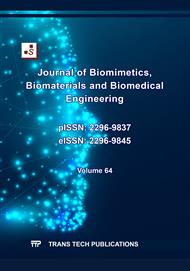[1]
Vlajinac, H. D., Marinković, J. M., Maksimović, M. Z., Radak, D. J., Arsić, R. B. et al. The prevalence of polyvascular disease in patients with carotid artery disease and peripheral artery disease. Kardiologia Polska (Polish Heart Journal), 77(10), 926-934. (2019)
DOI: 10.33963/kp.14945
Google Scholar
[2]
Lavie, C. J. Progress in Cardiovascular Diseases Statistics 2022. Progress in Cardiovascular Diseases, S0033-0620. (2022)
DOI: 10.1016/j.pcad.2022.08.005
Google Scholar
[3]
Rafieian-Kopaei, M., Setorki, M., Doudi, M., Baradaran, A., Nasri, H. Atherosclerosis: process, indicators, risk factors and new hopes. International journal of preventive medicine, 5(8), 927. (2014)
Google Scholar
[4]
Canstein, C., Cachot, P., Faust, A., Stalder, A. F., Bock, J. et al. 3D MR flow analysis in realistic rapid-prototyping model systems of the thoracic aorta: comparison with in vivo data and computational fluid dynamics in identical vessel geometries. Magnetic Resonance in Medicine: An Official Journal of the International Society for Magnetic Resonance in Medicine, 59(3), 535-546. (2008)
DOI: 10.1002/mrm.21331
Google Scholar
[5]
Tu, J., Inthavong, K., Wong, K. K. L., Tu, J., Inthavong, K. et al. Computational Haemodynamics—An Introduction. Computational Hemodynamics–Theory, Modelling and Applications, (2015) 1-19.
DOI: 10.1007/978-94-017-9594-4_1
Google Scholar
[6]
Zhang, J. The application and development of artificial blood vessels. 2016 4th International Conference on Mechanical Materials and Manufacturing Engineering, 507-510. Atlantis Press. (2016)
Google Scholar
[7]
He, C., Gu, Y., Zhang, J., Ma, L., Yan, M. et al. Preparation and modification technology analysis of ionic polymer-metal composites (IPMCs). International Journal of Molecular Sciences, 23(7), 3522. (2022)
DOI: 10.3390/ijms23073522
Google Scholar
[8]
Wu, L., Jiao, Z., Song, Y., Liu, C., Wang, H. et al. Experimental investigations on drag-reduction characteristics of bionic surface with water-trapping microstructures of fish scales. Scientific Reports, 8(1), 12186. (2018)
DOI: 10.1038/s41598-018-30490-x
Google Scholar
[9]
Tian, G., Zhang, Y., Feng, X., Hu, Y. Focus on bioinspired textured surfaces toward fluid drag reduction: Recent progresses and challenges. Advanced Engineering Materials,24(1), 2100696. (2022)
DOI: 10.1002/adem.202100696
Google Scholar
[10]
Sriyab, S. The effect of stenotic geometry and non-Newtonian property of blood flow through arterial stenosis. Cardiovascular & Haematological Disorders-Drug Targets (Formerly Current Drug Targets-Cardiovascular & Hematological Disorders), 20(1), 16-30. (2020)
DOI: 10.2174/1871529x19666190509111336
Google Scholar
[11]
De Vita, F., De Tullio, M. D., Verzicco, R. Numerical simulation of the non-Newtonian blood flow through a mechanical aortic valve: Non-Newtonian blood flow in the aortic root. Theoretical and computational fluid dynamics, 30, 129-138. (2016)
DOI: 10.1007/s00162-015-0369-2
Google Scholar
[12]
Wang, C., Li, Y., Liu, B., Xiang, H. Z., Xu, K. et al. Research on measurement of vessel diameter based on clustering algorithm. Optical Technique, 47(1): 37. (2021)
Google Scholar
[13]
Bi, R., Du, Y., Attia, A., Ho, J. H. C., Olivo, M. A speckle-based method for fast blood flow measurement in deep tissue. Optical Biopsy XIX: Toward Real-Time Spectroscopic Imaging and Diagnosis (Vol. 11636, p.1163606). SPIE. (2021)
DOI: 10.1117/12.2578106
Google Scholar
[14]
Gu, Y., Ma, L., Yan, M., He, C., Zhang, J. et al. Strategies for improving friction behavior based on carbon nanotube additive materials.Tribology International, 107875. (2022)
DOI: 10.1016/j.triboint.2022.107875
Google Scholar
[15]
Lin, Z., Zheng, F., Ding, J., Li, J. Blood Flow Velocity Detection of Nailfold Microcirculation Based on Spatiotemporal Analysis. Pattern Recognition and Computer Vision: Third Chinese Conference, PRCV 2020, Part (pp.681-695), Nanjing, China. (2020)
DOI: 10.1007/978-3-030-60633-6_57
Google Scholar
[16]
Pan, L. H., Zhang, X. Y., Li, Z. L., Nan, N., Bu, Y., et al. Measuring Velocity of Blood Flow Based on Photoacoustic Correlation Spectroscopy. Chinese Journal of Lasers, 45(11), 1107001-1. (2018)
DOI: 10.3788/cjl201845.1107001
Google Scholar
[17]
Li, B. FSI basend fundarmental research on the hemodynamic model with transmission load and biomechanical behaviors of aneurism. Beijing University of Technology. (2017).
Google Scholar
[18]
Xu, Y. Clinical application value of B-ultrasound in the measurement of portal vascular diameter in patients with cirrhosis. Journal of Imaging Research and Medical Applications, 4(13), 180-181. (2020)
Google Scholar
[19]
Gu, Y. Q., Zhang, J. J., Yu, S. W., Mou, C. Q., Li, Z. et al. Unsteady numerical simulation method of hydrofoil surface cavitation. International Journal of Mechanical Sciences, 228, 107490. (2022)
DOI: 10.1016/j.ijmecsci.2022.107490
Google Scholar
[20]
Hu, K., Li, Y. X., Ke, Z. X., Yang, H. J., Lu, C. J.et al. History, progress and future challenges of artificial blood vessels: a narrative review. Biomaterials Translational, 3(1), 81. (2022)
Google Scholar
[21]
Dean, B., Bhushan B. The effect of riblets in rectangular duct flow. Applied Surface Science, 258(8), 3936-3947. (2012)
DOI: 10.1016/j.apsusc.2011.12.067
Google Scholar
[22]
Li, C. S., Feng. H. Q., Ma, S. Q., Bai, L. P. Effect of biomimetic woven coronary stent implantation on hemodynamics. Journal of Biomedical Engineering, 39(02), 339-346. (2022)
Google Scholar
[23]
Qi, J., Qi, Y., Chen, Q., Yan, F. A. Study of Drag Reduction on Cylinders with Different V-Groove Depths on the Surface. Water, 14(1), 36. (2021)
DOI: 10.3390/w14010036
Google Scholar


